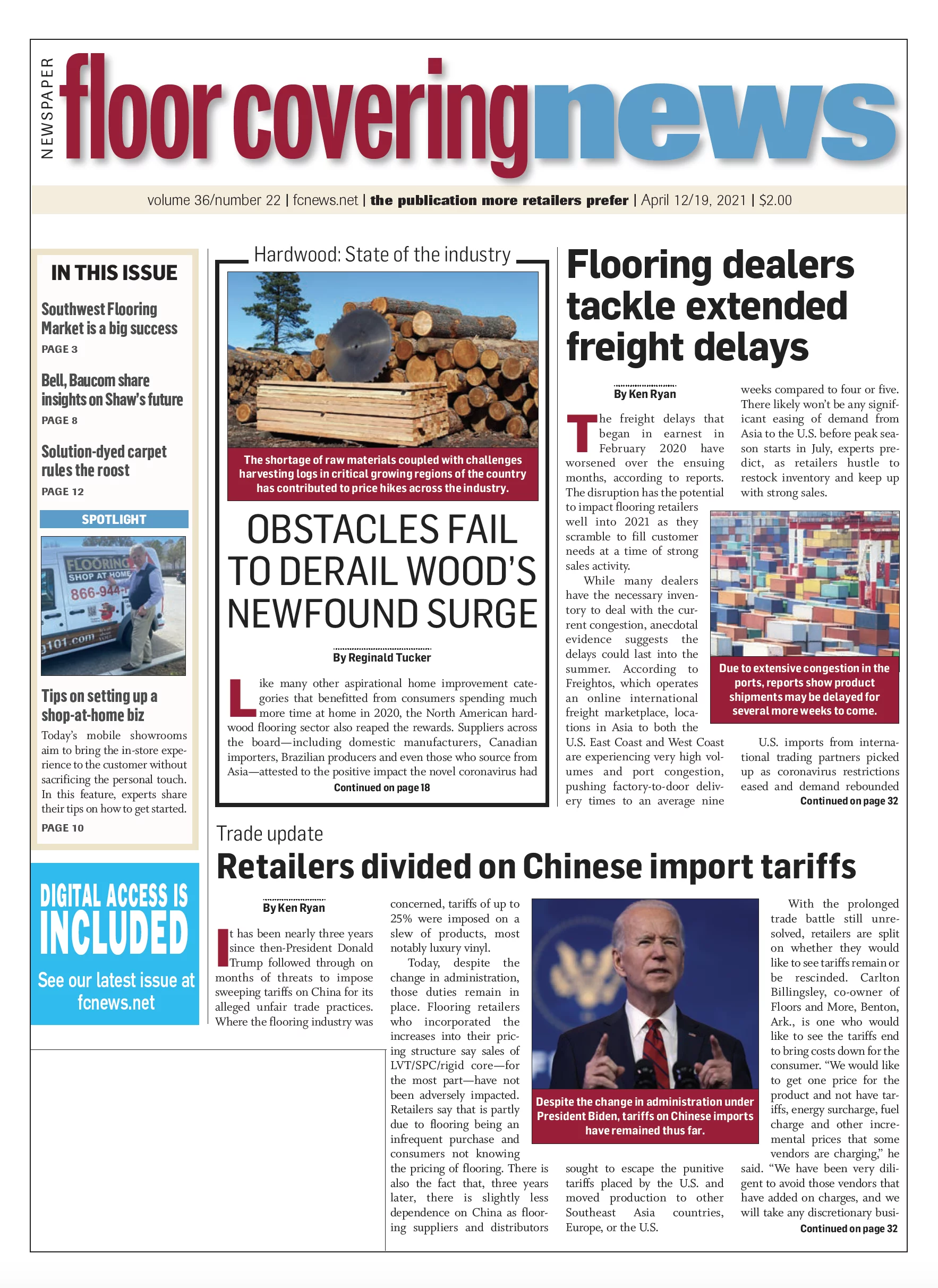 Founded in 1975 in the basement of the Shah family’s Fort Wayne, Ind., home, MSI began as an importer of rough-block granite. Today, the company has grown into a multi-category flooring supplier with over $2 billion in annual revenue with additional expansion on the horizon.
Founded in 1975 in the basement of the Shah family’s Fort Wayne, Ind., home, MSI began as an importer of rough-block granite. Today, the company has grown into a multi-category flooring supplier with over $2 billion in annual revenue with additional expansion on the horizon.
In a nutshell, the company sources the globe for its products, and through its 30-plus distribution centers across the U.S. and Canada, aims to deliver them when, where and how its customers need them. Its state-of-the-art information system forecasts customer demand and manages inventory levels to ensure all products and services are provided on time.
The company’s ascension to the powerhouse it is today—while more than doubling in the last five years—has been incremental since its founding. After 10 years of steady progress, MSI hit a turning point in 1984, when the business outgrew its Fort Wayne roots. The decision was made to move to California, where it remains headquartered today. “What [my parents] really saw was an opportunity to bring natural stone to the middle class,” said Raj Shah, president.
In 1988, the company got its first warehouse in Santa Fe Springs, Calif., and the business continued to expand into adjacent categories such as marble and natural slate. In 2008, MSI entered the man-made business with the addition of porcelain and ceramic tile flooring and quartz countertops. Recently, the company has expanded most notably into the booming resilient category with a full lineup of both flexible and rigid core product lines. It has also just begun to tip its toe into the laminate and hardwood categories.
Overall, MSI imports more than 65,000 containers per year and manages hundreds of millions of square feet of stock.
FCNews sat down with Shah to get an update on the company’s progress. Following are excerpts of that discussion.
What would you say your competitive advantage is vs. your competition?
I think there are a couple of things. Generally speaking, we don’t manufacture our product. We’re not tied to what our factory makes. A lot of [tile] factories only make 12 x 24 sizes; some factories only make polished, some rectified. We’re not tied to any one of those. We look at what the consumer wants, and we work backward from there. So, we can bring the product consumers want.
No. 2, price. I think a lot of people in our industry are trying to find ways to make the product more expensive, whether that’s through branding, packaging, etc. Our goal is to make this more and more affordable and accessible to more and more consumers because we really believe the money is where the mass is. That doesn’t mean our retail customers make less money. We want that chain to make more money. That’s where the trick is. We’re working every day to engineer processes to make that happen.
Next, MSI is affordable and accessible. We have this nationwide network of warehouses. We have our own delivery trucks, and we add a lot of information services. If you ask my dad, he’ll tell you we’re not really in the business of tile and stone and flooring. We’re in the business of information. Our goal has always been to make it easy and painless for a retailer to transact with us. We want to give the retailer all the information they need to close the customer when she’s in the shop. And we’re helping produce the pull. Whether it’s marketing, our visualization tools or our dealer locator, we’re helping produce the pull for the retailer. As a retailer, you automatically get some sales just by having our product on your shelf.
Does MSI inventory everything it sells?
We do inventory everything we sell. We’re not a special-order house or a high-lead-time house. A big piece of that is the value proposal. We do have hundreds of millions of square feet in stock.
Every warehouse that you have has a showroom, too?
That’s correct. Mr. and Mrs. Jones can walk in. But, they can’t buy product. It’s really a showroom for our retailers. Our retailer customers send their customers here knowing we will not sell underneath them or around them. Yes, Mr. and Mrs. Jones can walk in, they’ll be asked who their fabricator or retailer is and if they don’t have one, we say, “You’re welcome to walk around, we’ll write down what you like and then we’ll find a retailer for you to buy it from.”
Any plans to manufacture your own SPC in the U.S. one day?
We continue to look at that and learn more each day. Just because of our business model, we would never say no, but it’s just a little bit tougher to add value because we’re not necessarily bringing our sourcing expertise to it. Our job is to hedge some of the uncertainty for retailers—whether that’s lead time, pricing, shipping—and our inventory is their hedge against uncertainty.
What are the differentiation points with your LVT/SPC?
The true differentiation goes back to affordability and accessibility, and we feel like our products are a lot more on trend. Luckily, we have a broad base of products and we can interchange trends. We are able to see trends across the board and our sourcing, product and trend teams are very focused on looking at our own portfolio and seeing what is working in a particular segment. If it’s working, let’s spread it. If it’s not working, let’s understand why it’s not.
Biggest obstacle to growth right now?
Supply and manpower are probably the biggest issues. Demand is not a problem today, and I don’t foresee demand being a problem for the next 24/36 months, if ever. The government’s about to print $2 trillion of money. The No. 1 place that goes is to pay down debt; the No. 2 place is home improvement. I do see supply and inflation being a big problem across the board. I think the real value of money will fall, whether that’s inflation or the dollar losing its value. Generally speaking, wages will go up, but prices will also rise in conjunction. Real wages may decrease, and I do see that as a problem over the next few years.
Let’s talk about last year—pandemic year. How was business? Did you do anything differently to continue to grow the business?
We did a lot differently, and we learned a lot over time. If you go back to March of last year, just like everyone else, we were very scared. Our projection was very Draconian, and we really buckled down. So, the first four to 12 weeks of this was a demand problem, and we went back to our playbook from 2008—let’s go get market share. The great thing about this industry is nobody has huge market share; even if the industry shrinks, there’s a lot of market share to take and to help our retail customers take.
But by August, the No. 1 thing we were hearing about was fulfillment rates in the industry. It wasn’t, “Hey, we have nobody walking in the door.” It was, “We have no inventory. Who can help us get inventory?” This was the first time, at least since I can remember, that it was a major supply issue across the board. We really had to focus in on the supply side. That became our No. 1 focus—to help our retailer. That is where one of the advantages of MSI came into play—our quick and fast adaptability to changes in the marketplace. It was the speed of change that our team really knew how to take advantage of. And it’s because we have this worldwide network of supply that we were able to move quickly and help our retail customers.
The other thing we did is spend a lot of time on our own employee base. We put into place a lot of benefits we hadn’t had before. We never cut pay; we upped bonuses; we gave significant raises. We gave laptop computers to all of our hourly employees because what we realized was that schooling was happening from home and a lot of families weren’t equipped to handle that. We started free tutoring services to all our employees’ kids and that allowed their parents to really focus on work. We weren’t going to let our employees, or their children, be hurt because of what was going on. That was important to us. We’re coming up on 2,000 laptops for MSI. And we’ve donated a lot more to the community at large.
What’s on the horizon for this company?
There’s no lack of opportunity and challenges over the next year or three or five for this company. In flooring, we’ve entered the laminate and wood categories. That’s the next thing. It’s almost an extension of LVT—it’s the same customer base and, in some ways, the same vendor base. Trend and product selection are also very similar. That will expand.
We’re also going to continue our distribution strength—opening more warehouses. (We’re at 36. We have nine new ones in the works for the next 12 months, and we’re continuously working to find more.) Real estate is becoming tougher to find and manpower harder to hire. That’s a challenge, but we really want to master the distribution side of it.
A subset of that is delivery. We want to deliver 90%-plus of our floor covering on our own trucks and really own that last mile to make it even easier for our retail customers to take advantage of the product lines. We have hundreds of trucks now and we’ve made a large investment recently. We’re making a big initiative to deliver most of the flooring, not just tile, on our own trucks.
Our goal is to grow at double the market rate. Generally speaking, the market for floor covering has been growing at 5%-6% after the Great Recession. Luckily, we’ve been blessed with great products, a great team and great customers.

